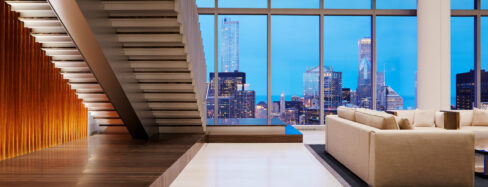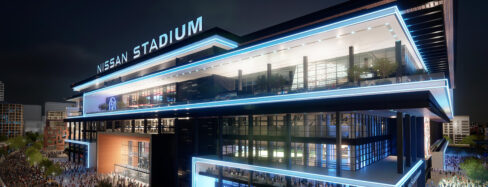Frit in architecture has many benefits, including increasing energy efficiency, improving bird safety for structures with significant or prominent glazed areas, or simply adding an aesthetic quality and character to a building. In daylighting design, we also consider frit as a means of solar control. However, after reflecting upon numerous projects where frit has been specified, the daylighting team at HLB has come to realize there are some mysterious caveats that seem to come with the use of fritted glass.
First, what is frit? Frit is simply a layer of ceramic enamel deposited directly on one or more of the surfaces within an insulated glazing unit (IGU). It is most often printed to show parallel lines or circular dots in standard or custom patterns, and can vary in coverage density, typically from 5 – 100%. Manufacturing limitations reduce the range of densities available in certain patterns, as well as the color and opacity of the printed enamel, but design options are endless.
Frit can be a good strategy to reduce the perceived intensity of the bright sky by physically blocking partial light, and with fine dots or lines, appearing indistinguishable from tinted glass at a distance. However, it is less successful at taming a powerful source of light such as direct sunlight. Here, only frit densities above 60-80% can begin to show real sun control capabilities, and only in conjunction with greatly reducing the glazing substrate’s visible light transmittance. When faced with the sun itself as a glare source in view, frit can only work well if it is able to disrupt the glowing solar orb by breaking it into several smaller pieces, thereby creating a more visually comfortable scene. The effectiveness of frit for solar control can vary considerably with orientation, glare requirements, desired appearance, and preferences for unimpeded views to the outside.
Additionally, frit color and opacity can have a significant impact on the effectiveness for solar control. Choosing between diffusing and opaque frit will affect the overall transmittance of an IGU as well as its appearance. There are even “clear” frits printed with ultraviolet ink that have a minimal visual presence to the human eye, but appear opaque to birds – who can see UV wavelengths – and can prevent them from striking an otherwise nearly invisible and often deadly barrier. Diffusion redirects incident sunlight but also results in surfaces that light up under the sun or bright clouds, and may even become a source of glare. Similarly, light colors facing the interior of a building can appear overly bright or decrease contrast with the exterior, reducing opportunities to preserve access to views. Light colored frit facing out makes glass surfaces much more reflective, enhancing the thermal performance of the IGU by day, but also highly reflective at night, which may or may not be desirable from a design standpoint. Conversely, darker colors as seen from the interior enhance views, but absorb solar heat when facing out. Fortunately, printing technology now allows for the application of different colored frits for exterior- and interior-facing glass surfaces, overlaying the patterns with great precision to achieve the intended result while avoiding any undesirable moiré effects.
In our daylighting simulations, we consider overall sky brightness, but pay special attention to the solar orb (as well as its reflections!) as the ultimate cause of glare. Our process begins by studying the entirety of the solar path, as seen from positions of critical tasks within the building and quantifying the glare tolerance at these locations. Without considering the frit density just yet, our methodology then identifies the glazing units in the model that let in the glare at various times for each critical task location. Next, we temporarily replace these units with opaque spandrel and confirm the absence of glare conditions through simulations. Then, the spandrel is replaced by progressively less dense frit patterns until unacceptable glare is seen, thus defining a minimum frit density for the given visible light transmittance.
Finding the optimal compromise between glare control, thermal control, view preservation and aesthetic appearance defines the challenge we face when conveying to architects the fact that the application of most grades of frit will not completely eliminate glare, even with high density. Have you ever noticed that it is virtually impossible to find a publicity photo of fritted glass taken from inside the building when the sun is striking that surface? That’s because intolerable glare does not a pretty picture make. In reality, blinds or other visual comfort shades would be required to make such a space comfortable, if appropriate architectural interventions such as overhangs, vertical fins, or brise soleil were not utilized.
Unfortunately, the desire for transparent building enclosures too often results in the selection of inappropriately low-density frit patterns and high visible light transmittance glazing build-ups, with glare problems being addressed in post-occupancy, and often with solutions (such as roller shades, occluding films or even random sheets of paper!) that were considered undesirable during the design process. Views, often considered a top design priority, become compromised anyway.
Frit, used in moderation, can still achieve view-through depending on the occupant’s distance from the glazing, contrary to the misconception that it will obstruct the view to the outside. However, the frit densities required to serve as the only means for sun control will almost certainly be obtrusive and obliterate views. This, coupled with the fact that the experience of glare can be highly subjective, particularly for viewers of different age groups, is why, despite the best simulations, it is still imperative to view physical samples and mockups to make a final determination of the frit selection. Often simply looking through a sample under the right sky conditions can help determine how the fritted glazing will be and if the glare experienced is acceptable. By understanding occupants’ true sensitivity to glare, performing quantitative simulations and directly viewing appropriate physical samples, a design team can effectively determine the appropriate frit- if any- to serve as a means of solar control for any project.


